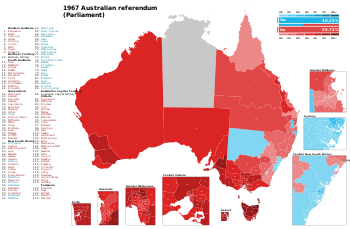
Summary
The first part of the 1967 Australian referendum to change the Constitution was the Parliament question, which related to the relative number of members in each house of the Australian Parliament − the so-called "nexus". The 1967 Australian referendum called by the Holt government on 27 May 1967 consisted of two parts, with the second question relating to Aboriginal Australians.
| ||||||||||||||||||||||
Question 1 Do you approve the proposed law for the alteration of the Constitution entitled— 'An Act to alter the Constitution so that the number of members of the House of Representatives may be increased without necessarily increasing the number of Senators'? | ||||||||||||||||||||||
| Results | ||||||||||||||||||||||
|---|---|---|---|---|---|---|---|---|---|---|---|---|---|---|---|---|---|---|---|---|---|---|
| ||||||||||||||||||||||


Results by county | ||||||||||||||||||||||
Section 24 of the Australian Constitution requires that the number of members in the House of Representatives be, as nearly as possible, twice the number of members in the Senate.[1] The most important effect of the "nexus" in the Australian Constitution is to prevent the dilution of the collective voting power of the Senate, which represents the Australian states equally, in any joint sitting of both houses following a double dissolution election. The nexus ensures that Senators will always have about one-third of the votes in a joint sitting, and Members of the House of Representatives about two-thirds. The referendum question asked the public to vote on whether "the number of members of the House of Representatives may be increased without necessarily increasing the number of Senators".[2] It was defeated, with 59.75% of voters voting "No" to this question.
Question edit
Do you approve the proposed law for the alteration of the Constitution entitled 'An Act to alter the Constitution so that the number of members of the House of Representatives may be increased without necessarily increasing the number of Senators'?
Results edit
| State | Electoral roll | Ballots issued | For | Against | Informal | |||
|---|---|---|---|---|---|---|---|---|
| Vote | % | Vote | % | |||||
| New South Wales | 2,315,828 | 2,166,507 | 1,087,694 | 51.01 | 1,044,458 | 48.99 | 34,355 | |
| Victoria | 1,734,476 | 1,630,594 | 496,826 | 30.87 | 1,112,506 | 69.13 | 21,262 | |
| Queensland | 904,808 | 848,728 | 370,200 | 44.13 | 468,673 | 55.87 | 9,855 | |
| South Australia | 590,275 | 560,844 | 186,344 | 33.91 | 363,120 | 66.09 | 11,380 | |
| Western Australia | 437,609 | 405,666 | 114,841 | 29.05 | 280,523 | 70.95 | 10,302 | |
| Tasmania | 199,589 | 189,245 | 42,764 | 23.06 | 142,660 | 76.94 | 3,821 | |
| Total for Commonwealth | 6,182,585 | 5,801,584 | 2,298,669 | 40.25 | 3,411,940 | 59.75 | 90,975 | |
| Results | Obtained majority in one state and an overall minority of 1,113,271 votes. Not carried | |||||||
See also edit
References edit
- ^ Constitution (Cth) s 24 Constitution of House of Representatives.
- ^ Constitution Alteration (Parliament) 1967 and Constitution Alteration (Aboriginals) 1967: The arguments for and against, Commonwealth of Australia, 6 April 1967, retrieved 3 June 2020 – via Trove
- ^ Handbook of the 44th Parliament (2014) "Part 5 - Referendums and Plebiscites - Referendum results". Parliamentary Library of Australia.
Further reading edit
- Austats Special Article on the History of Pensions and other Benefits in Australia
- Standing Committee on Legislative and Constitutional Affairs (1997) Constitutional Change: Select sources on Constitutional change in Australia 1901–1997 Archived 5 June 2011 at the Wayback Machine. Australian Government Printing Service, Canberra.
- Bennett, Scott (2003). Research Paper no. 11 2002–03: The Politics of Constitutional Amendment Archived 16 February 2012 at the Wayback Machine Australian Department of the Parliamentary Library, Canberra.
- Australian Electoral Commission (2007) Referendum Dates and Results 1906 – Present AEC, Canberra.


